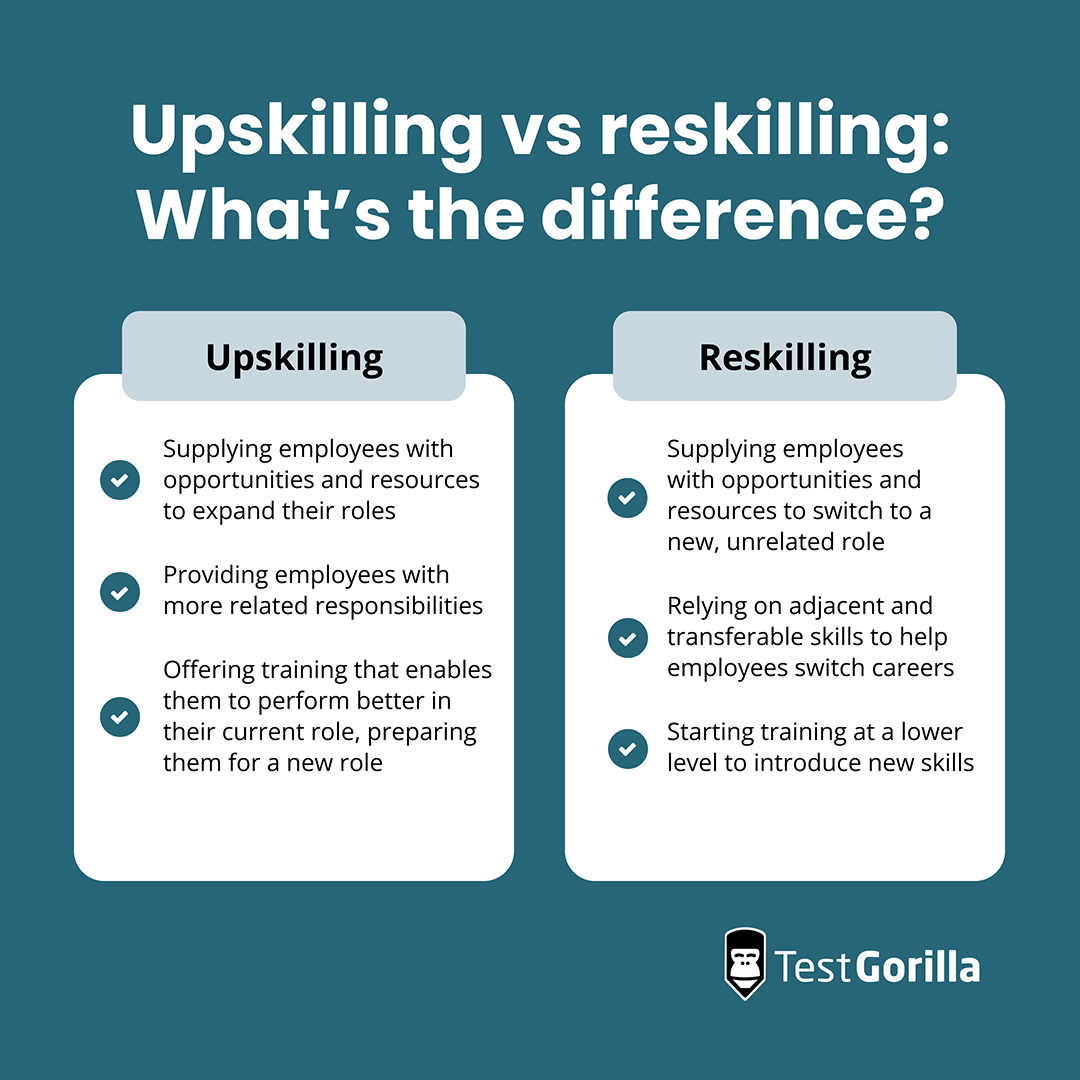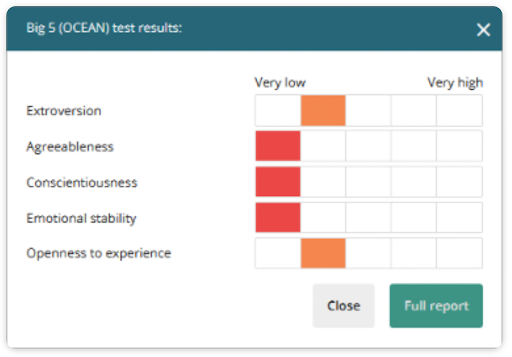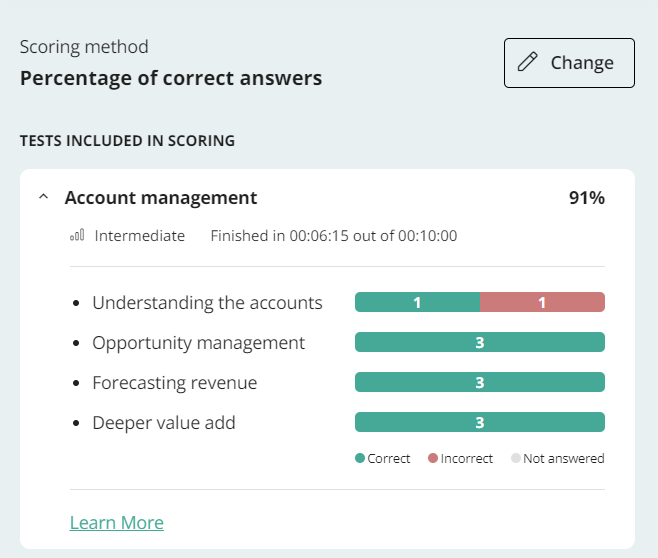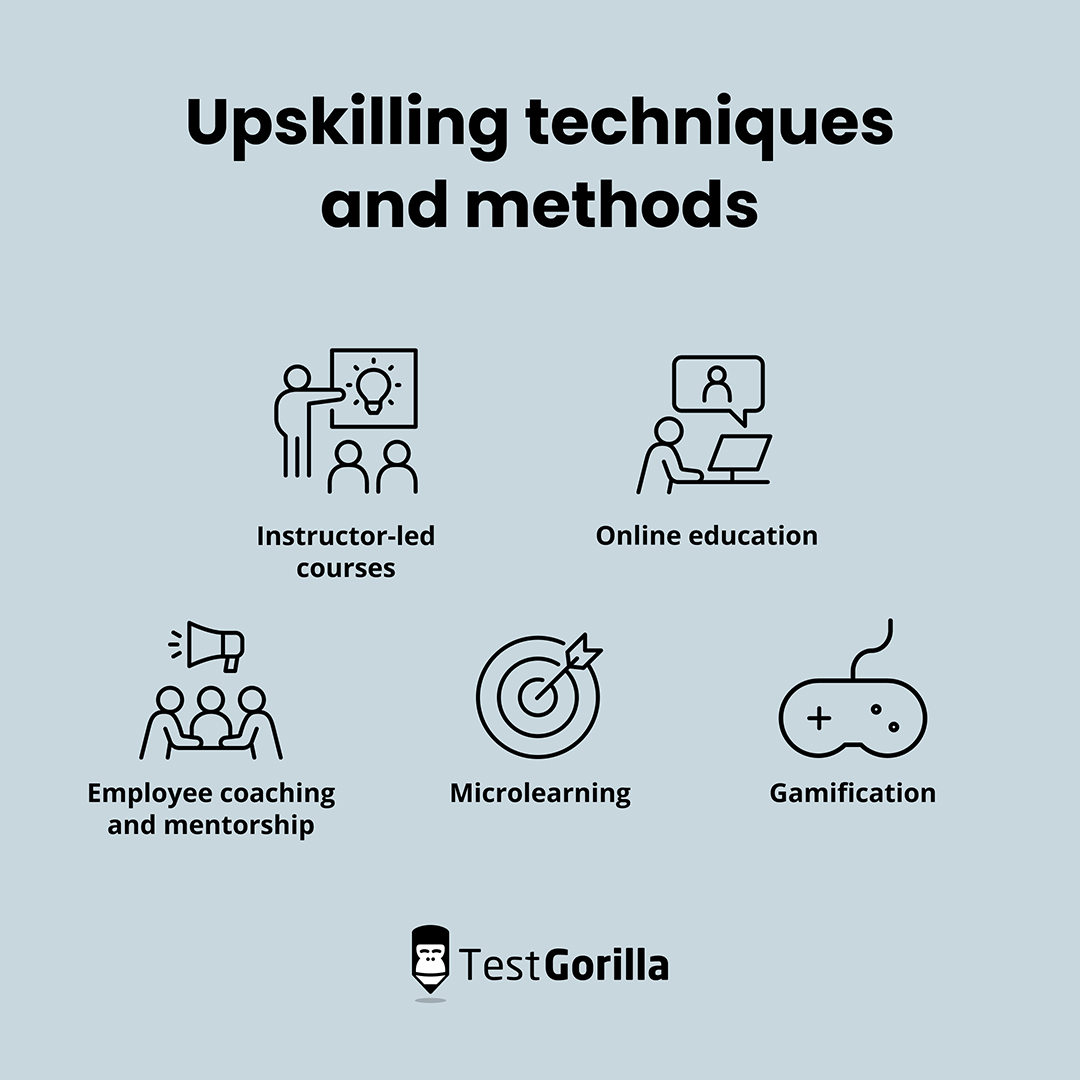Upskilling: Leverage this retention strategy and develop your team
Upskilling employees is crucial for modern companies. One study found that 64% of L&D professionals agree that learning and development have shifted from “nice-to-have” to “need-to-have.”[1]
Providing development opportunities to your people improves job satisfaction and increases retention – employees want career growth, and if they don’t get it, they’ll find someplace new.
Two of the main factors that keep people in their roles are learning new skills and professional growth.[2]
Upskilling also helps you stay competitive in the marketplace. What if your competition starts using machine learning to automate trading activities, but you don’t have anyone on staff with the right data science skills?
This talent retention strategy enables you to secure your most ambitious performers and leverage new trends without costly external hiring.
Our blog details the importance of employee upskilling and the top tactics to implement upskilling programs in your organization so you can stay agile and adaptable.
Table of contents
- What is upskilling?
- Why is employee upskilling important?
- The benefits of upskilling employees
- 7 best practices for leveraging employee upskilling to retain your best performers
- 3 examples of companies succeeding with upskilling as a talent retention strategy
- Take upskilling to new heights with talent assessments
What is upskilling?
Upskilling is when a company provides an employee with learning opportunities and resources to expand their skill sets and minimize skill gaps. It helps employees grow in their current career path, learning new skills that are adjacent but outside of their current role.
For example, an intermediate Scala programmer can upskill by learning advanced algorithms skills, preparing them for a more senior role.
Although similar, it’s important to note the distinction between training and our upskilling definition.
Upskilling teaches employees related skills that are beyond their role’s requirements. Training helps employees understand baseline job requirements, such as a sales development representative training to use a company CRM.
But this same sales development representative may choose to pursue management skills, and that would be upskilling.
Although training is a standard requirement for a role, upskilling challenges employees and gives them satisfying career growth.
Practicing upskilling also helps you tackle certain talent retention trends.
For example, adopting an employee upskilling program helps your organization improve its corporate reputation.
Upskilling is also similar to but different from job enrichment, which goes beyond adding extra responsibilities and focuses on motivation and engagement.
Upskilling vs reskilling: What’s the difference?
Upskilling at work is sometimes mistaken for a similar practice called reskilling. Although both efforts aim to teach employees new things and grow their careers, they’re different.
Upskilling initiatives seek to teach employees skills outside of their current positions but still related to their main role and career path. Reskilling aims to teach employees skills that move them into a brand-new position with only a few transferable skills in common.
Here’s a quick summary:
Upskilling | Reskilling |
- Supplying employees with opportunities and resources to expand their roles - Providing employees with more related responsibilities - Offering training that enables them to perform better in their current role, preparing them for a new role | - Supplying employees with opportunities and resources to switch to a new, unrelated role - Relying on adjacent and transferable skills to help employees switch careers - Starting training at a lower level to introduce new skills |
To read about this topic in-depth, check out our full guide on upskilling and reskilling employees.
Why is employee upskilling important?
Upskilling programs, particularly digital upskilling to teach data literacy, are becoming more vital day by day.
Here are a few of the top reasons why upskilling employees is essential:
Skills are quickly becoming obsolete due to technological shifts (like digital transformation, artificial intelligence, and automation)
The war for talent is ongoing
Learning and development attract and retain top talent, acting as strong incentives
Focusing on skills helps build a skills-based organization, improving efficiency, adaptability, and innovation
Employee upskilling is a solid solution to many issues, which is quickly making it the norm in every industry.
Learning how to upskill employees is crucial for every organization:
Gives employees what they need: Many employees need to learn new skills to stay productive and properly grow their careers, but upskilling programs also give people the necessary satisfaction and engagement.
Decreases external hiring needs: Internal hiring reduces costs, which is always beneficial, but it’s even more important during a skills shortage.
Encourages an adaptable workforce: Upskilling and a culture of learning promote adaptability, which increases performance and flexibility.
Increases organizational agility: The skills needed to make a business run well are changing every day. Having an effective upskilling strategy helps you stay current and productive.
The ability to quickly and efficiently enhance your workforce’s skills is crucial for a number of reasons, but agility is a top concern. Many current leaders must learn how to upskill staff effectively to address unprecedented challenges and instill confidence.
Adaptability is non-negotiable for leaders in the current climate:
Only 44% of employees say they trust their organization’s leaders to navigate large changes well
Only 19% of HR leaders report that their workforce can effectively change direction based on shifting needs and priorities
68% of HR leaders identified building critical skills and competencies as their top priority
Agility is essential in a modern workforce due to constantly shifting needs, skills shortages, unpredictable events, and economic crises. For example, many skills-based organizations benefited from their agility during the 2020 pandemic.
Upskilling at work is also important to your team.
Career development is one of the most expected employee benefits in the modern working world, providing much-needed and wanted professional growth.
And this development means more than just increased employee compensation. Helping your people build new skills shows them that their employer cares about their career growth, which helps connect employees to their work and increases company loyalty.
The best insights on HR and recruitment, delivered to your inbox.
Biweekly updates. No spam. Unsubscribe any time.
The benefits of upskilling employees
Upskilling employees is vital to the health of your organization.
Would you even notice the detriments to your company of not having upskilling plans in place? Chances are you already do – you just think of these drawbacks as par for the course of running a team.
For example, employee turnover is a natural thing, but it could be much lower with an effective employee upskilling program in place.
Let’s take a close look at the benefits of upskilling staff.
1. Increases retention
Every employee is looking to grow professionally, and employers need to facilitate it. If organizations don’t help their people develop, these workers often start looking for new jobs.
Learning how to upskill employees has a powerful impact on your employee retention rate:
93% of executives who introduced advanced upskilling programs see improved talent acquisition and retention.[3]
61% of workers consider upskilling “extremely” or “very” important when deciding whether or not to remain at their current job.
Offering people learning opportunities and the chance to acquire new skills improves the entire employee experience, providing them with healthy challenges and facilitating their career growth.
Employees want to know they have a solid future with you, and if they do, they’ll hopefully stay for years to come.
2. Increases productivity and performance
Equipping employees with novel technical skills helps them do their jobs faster and more efficiently.
Upskilling is an effective tool for increasing workplace productivity and performance – more than 90% of executives see greater productivity and innovation from advanced upskilling programs.[3]
Providing people with fresh skills also enables your workforce to stay productive in the face of massive changes.
Employees know how fast the world is changing and that they need to keep up: 33% of American workers say learning new skills is important, and 54% say it's essential.[4]
The more the world shifts, the more your employees need innovative skills to maintain productivity and performance.
3. Boosts engagement
Upskilling employees drives higher employee engagement for two main reasons.
First, employer-provided development opportunities connect people to their work in a meaningful way, increasing their overall motivation.
Second, it also prevents harmful job stagnation. Employees who are in one position for too long grow weary and bored, usually opting to accomplish the bare minimum. This phenomenon is also known as quiet quitting.
An impressive 80% of professionals believe that learning new skills will help their engagement.[5]
Showing your people that you support their professional growth is a crucial form of employee recognition that resonates with them and drives their hard work.
4. Promotes internal mobility
Creating more upskilling programs encourages a culture of learning and internal mobility, fostering an environment of internal promotions, skills development, and growth.
Internal mobility causes its own slew of benefits, including attracting top talent and reducing external hiring costs.
It also increases engagement and retention. In fact, 81% of talent professionals agree that internal recruitment boosts retention.[6]
Building a culture of learning and development also positively affects your employee attrition rate.
Internal mobility not only helps retain your staff and prevent voluntary turnover, but it also provides employees with other necessary skills in case their jobs are ever at risk of becoming obsolete. Otherwise, employers would be forced to let go of great people, increasing attrition.
7 best practices for leveraging employee upskilling to retain your best performers
Adding to your employees’ skill sets and helping them grow their careers is essential, but you need to use the right tactics.
Learn how to upskill employees effectively using our best practices, including personalizing learning programs and fostering a skills-based mindset.
Strategies to leverage upskilling: A summary
Strategy | What it accomplishes |
1. Adopt skills-based practices | Facilitates upskilling by emphasizing skills and equipping you with training resources, such as talent assessments |
2. Hire adaptable people with potential | Assists employee upskilling programs by ensuring workers have key learning skills, such as adaptability |
3. Assess skills gaps and align upskilling efforts with business goals | Ensures your upskilling initiatives target the right areas and target your company’s future needs |
4. Provide personalized training | Helps your employees learn how it’s best for them, making it easier to digest knowledge |
5. Leverage an internal marketplace | Makes upskilling easier by matching employees to real-life opportunities and gigs to increase skills |
5. Encourage a culture of learning | Creates an environment where learning is encouraged and natural |
6. Use a variety of upskilling techniques | Fosters an inclusive culture where every employee is able to upskill |
1. Adopt skills-based practices
Skills-based practices are taking the working world by storm, and many companies are seeing the benefits. An organization that focuses on skills is more agile and productive and encourages a healthier culture.
A skills-based mindset also sets you up for upskilling well because you naturally focus on an employee’s skills rather than other factors, such as tenure and work history.
This emphasis on skills makes you more prepared to handle learning and development. Here are a few upskilling examples in a skills-based environment:
A skills-based organization already uses talent assessments for hiring, so they decide to use them to measure the success of their upskilling program
An HR professional with a skills-based mindset already writes skills-focused job descriptions, so they firmly understand the skills needed for the role that an employee is upskilling into
Adopting skills-based practices also lays the groundwork for other agile, skills-focused practices, such as reskilling and talent sharing.
We recommend starting small with one or two skills-based practices, such as adopting inclusive hiring and assessing candidates with talent assessments.
2. Hire adaptable people with potential
You can lay a strong foundation for future upskilling by hiring the right people. This is also about hiring for potential rather than just hiring for experience.
Look for key skills and traits that help people learn and grow, such as:
Adaptability
Learning agility
Curiosity
Creativity
People who are more adaptable and curious are ready and willing to own their career growth and shoot for their goals. They’re also more likely to be self-motivated.
Adaptable employees are also essential for skills-based organizations and the future of work because they can easily hop from task to task.
The best way to discover these crucial traits and skills is by using personality tests. These assessments can tell you an employee’s work style and key motivators.
For example, here are one candidate’s results from our Big 5 (OCEAN) test:
This test ranks applicants on several characteristics. The bottom two are most relevant to upskilling because emotional stability and openness to experience influence how a person reacts to new situations, such as training programs and different job roles.
Learning key personality traits also helps you shape a better onboarding process by discovering how a new hire learns best and tailoring your approach to match. This helps new employees ramp up faster.
3. Assess skills gaps and align upskilling efforts with business goals
You can laser-focus your employee upskilling programs by conducting a skills gap analysis.
A skills gap analysis helps you understand your organization’s goals and where your workforce is missing crucial skills. This enables you to target current weak spots and prepare for future skills gaps.
This strategy is a data-driven approach to discovering exactly what’s missing in your workforce and what each employee needs instead of guessing or going with gut instinct.
A typical gap analysis involves manually evaluating each employee’s current skills to find areas of improvement, but it’s far easier to do with talent assessments.
Using talent assessments to understand your skill gaps brings much-needed accuracy and clarity to the process.
Dealing with precise percentages enables you to build highly accurate upskilling initiatives and laser-focus your efforts on exactly what the employee needs to learn.
4. Provide personalized training
One size doesn’t fit all – employees learn best when upskilling programs are personalized.
Here are a few ways to customize your upskilling programs:
Leverage skills gap analysis data to focus on the right areas of improvement
Assess employee personality traits and learning styles with talent assessments
Ask your people for their opinions on upskilling
Employee listening is one of the most powerful tools to leverage when you upskill employees.
Try issuing employee surveys or even just asking them personally during one on one meetings.
Ask your workforce about their preferred learning style, which skills they think would benefit them, and once training starts, how they’re progressing.
This tactic is crucial when developing all types of employee training programs. It’s essential that upskilling fits your company’s goals, but when you also take the time to personalize training, it helps learners absorb knowledge better by training them in the way that’s best for them.
5. Leverage an internal talent marketplace
An internal talent marketplace is a centralized platform where employees share their skills and their interest in certain roles and projects, and the system matches them with open roles.
These systems provide great upskilling opportunities for staff, offering employees real-life projects and gig opportunities to build their expertise and increase their responsibilities.
Older employees can list their availability for knowledge-sharing and mentorships, further facilitating your upskilling initiatives.
Internal talent marketplaces also help you advertise open positions and find recently upskilled employees to fill them with, efficiently recruiting internal hires and reducing costs.
To learn more about these systems and how to build one for your business, read our full guide on leveraging an internal talent marketplace.
These sprawling systems do more than just match suitable employees to opportunities and roles – they help structure your organization around learning, growth, and development. Let’s talk about fostering a learning culture next.
6. Encourage a culture of learning
One of the biggest obstacles to effective upskilling at work is culture and mindset.
If learning and development aren’t the norm in your company, leaders and employees won’t be accustomed to it and could resist it.
You can avoid this by adopting continuous learning as a core company value.
Encourage learning and skills development throughout your organization wherever possible, such as issuing formal training and upskilling, giving prompt employee feedback, and promoting growth opportunities through discussions and innovative conversations.
That last point is important: One of the fastest ways to encourage a learning culture is by framing everything as a learning opportunity, including mistakes and uncomfortable situations, such as a customer losing their patience with a sales associate.
Another way to encourage a culture of learning is by building a standardized system for creating professional development plans.
These documents establish an employee’s objectives, available resources, and the steps needed to achieve their career goals. They’re an excellent way to clarify an employee’s upskilling journey, detailing each step and milestone.
Helping your team members build these documents is a great way to show your stance on learning and development and work towards the greater goal of adopting it as a core value.
7. Use a variety of upskilling techniques
There are many different ways to upskill, depending on your company’s resources, structure, and needs.
A few upskilling methods include:
Instructor-led courses
Online education
Employee coaching and mentorship
Microlearning
Gamification
That last point is an easy way to supplement upskilling through your own workforce. For example, a company with great generational diversity may have an older employee who coaches younger ones as a part of their phased retirement plan.
Leveraging multiple upskilling techniques benefits an organization in many ways:
Caters training to different learning styles
Provides employees with engaging and diverse methods
Enables everyone to upskill, offering in-person training to in-office employees and online courses for remote workers
This enables every employee to upskill, even those with flexible work schedules – helping your company maintain a more inclusive culture.
3 examples of companies succeeding with upskilling as a talent retention strategy
Now let’s take a look at some excellent employee upskilling examples. These organizations recognize the importance of development and have taken great steps to encourage it.
Although these are stellar examples at global organizations, remember that upskilling can start at any scale, such as a single mentor-mentee relationship.
Companies retaining talent with upskilling: A summary
Company | Why it’s successful |
Marriott International | Provides its people with leadership skills training and uses it to fill many roles internally |
Amazon | Offers many upskilling programs, including ones for employees with non-traditional backgrounds |
PwC | Aims to upskill every member of its workforce to keep up with shifting trends |
Marriott International
Marriott International, a multinational hospitality company, has an award-winning leadership upskilling program.
This development program is 12 to 18 months long, self-paced, and leverages blended learning experiences, which means it’s part in-person and part online.
It offers training in a wide range of areas, including accounting and finance, culinary, engineering, event management, food and beverage, human resources, soft skills, revenue management, problem-solving, and room operations.
This company’s leadership program satisfies employees and benefits the company – within the Australian job market, it helped fill more than 55% of leadership positions with internal candidates.[7]
How does this focus on learning and development impact Marriott International’s retention?
This company has a 33% lower employee turnover rate than the industry average. It also spends roughly $150m less in employee costs due to higher retention.[8]
Amazon
Amazon is dedicated to learning and development, and its investments prove it.
This company poured $1.2bn into its Upskilling 2025 initiative – a project aiming to provide hundreds of thousands of employees with upskilling resources, including training programs and college tuition.
Amazon wants to future-proof its employees by supplying them with in-demand skills, both technical and non-technical.
One of the most popular programs in this initiative is the Amazon Technical Academy, a tuition-free, digital upskilling program that helps employees learn about software engineering and discover career opportunities.
This program focuses on instructor-led courses and real-world applications so people can quickly grasp software practices and tools and begin thriving in more senior roles.
Amazon also offers programs for entry-level candidates with non-traditional backgrounds, requiring no work experience and no college degrees.
PwC
PwC, a professional services company, has an impressive objective to upskill every one of its employees for the future.
Business needs are shifting, and this company is determined to remain competitive, help its people stay relevant, and build stronger digital skills across the firm.
To meet this lofty goal, PwC invested $3bn in this endeavor. It intends to train more than 250,000 workers over a four-year period, spending $2,700 to $3,600 per employee per year.
Its motive is to become a “talent magnet” and better retain its current staff, especially during technological transitions that threaten to make certain jobs obsolete.
PwC wants to guarantee its people a future, despite uncertain shifts in the workplace. Bob Moritz, its global chair, says he can’t guarantee that every employee will have the same role, but they’ll always have a place there.[9]
Take upskilling to new heights with talent assessments
Upskilling initiatives are essential to a healthy workplace. They ensure employees receive the growth they crave and stay with the company for the future.
Skill-building and development also provide your company with new capabilities and great internal hires, keeping you competitive and reducing hiring costs.
Start upskilling at whichever level is comfortable, from simple employee coaching all the way to a structured upskilling program that monitors employee progress via talent assessments.
We also recommend leveraging other forms of career development. For more information, read our guide on reskilling your employees.
To browse our collection of 400+ talent assessments, visit our test library.
Sources
1. "Workplace Learning Report". (2021). LinkedIn Learning. Retrieved December 19, 2023. https://learning.linkedin.com/content/dam/me/business/en-us/amp/learning-solutions/images/wlr21/pdf/LinkedIn-Learning_Workplace-Learning-Report-2021-EN-1.pdf
2. "2023 Workplace Learning Report". (2023). LinkedIn Learning. Retrieved December 19, 2023. https://learning.linkedin.com/content/dam/me/learning/en-us/pdfs/workplace-learning-report/LinkedIn-Learning_Workplace-Learning-Report-2023-EN.pdf
3. "Navigating the rising tide of uncertainty". (2020). PwC. Retrieved December 19, 2023. https://www.pwc.com/gx/en/ceo-survey/2020/reports/pwc-23rd-global-ceo-survey.pdf 4. “The State of American Jobs: How the shifting economic landscape is reshaping work and society and affecting the way people think about the skills and training they need to get ahead”. (October 2016). Pew Research Center. Retrieved December 19, 2023. https://www.markle.org/rework-america/state-american-jobs/
5. “2016 Workplace Boredom Report”. (2016). Udemy for Business. https://research.udemy.com/wp-content/uploads/2016/10/Workplace-Boredom-Study-2016-2021-Rebrand-v2-gs.pdf
6. "Global Talent Trends". (2020). LinkedIn Talent Solutions. Retrieved December 19, 2023. https://englishbulletin.adapt.it/wp-content/uploads/2020/01/linkedin-2020-global-talent-trends-report.pdf
7. Hilton, John. (October 31, 2019). "Marriott International is a people-first company". (2020). Human Resources Director. Retrieved December 19, 2023. https://www.hcamag.com/nz/specialisation/employee-engagement/marriott-international-is-a-people-first-company/190123
8. Godfrey, Paul C. "Valuing Culture: Putting a Price Tag on the Priceless". BYU Marriott School of Business. Retrieved December 19, 2023. https://marriott.byu.edu/magazine/faculty-research/valuing-culture-putting-a-price-tag-on-the-priceless
9. Hrala, Josh. (November 11, 2019). "CHROs: Here Are the Top Five Companies Investing in Upskilling in 2020". Career Minds. Retrieved December 19, 2023. https://careerminds.com/blog/here-are-the-top-five-companies-investing-in-upskilling-in-2020
You've scrolled this far
Why not try TestGorilla for free, and see what happens when you put skills first.



















